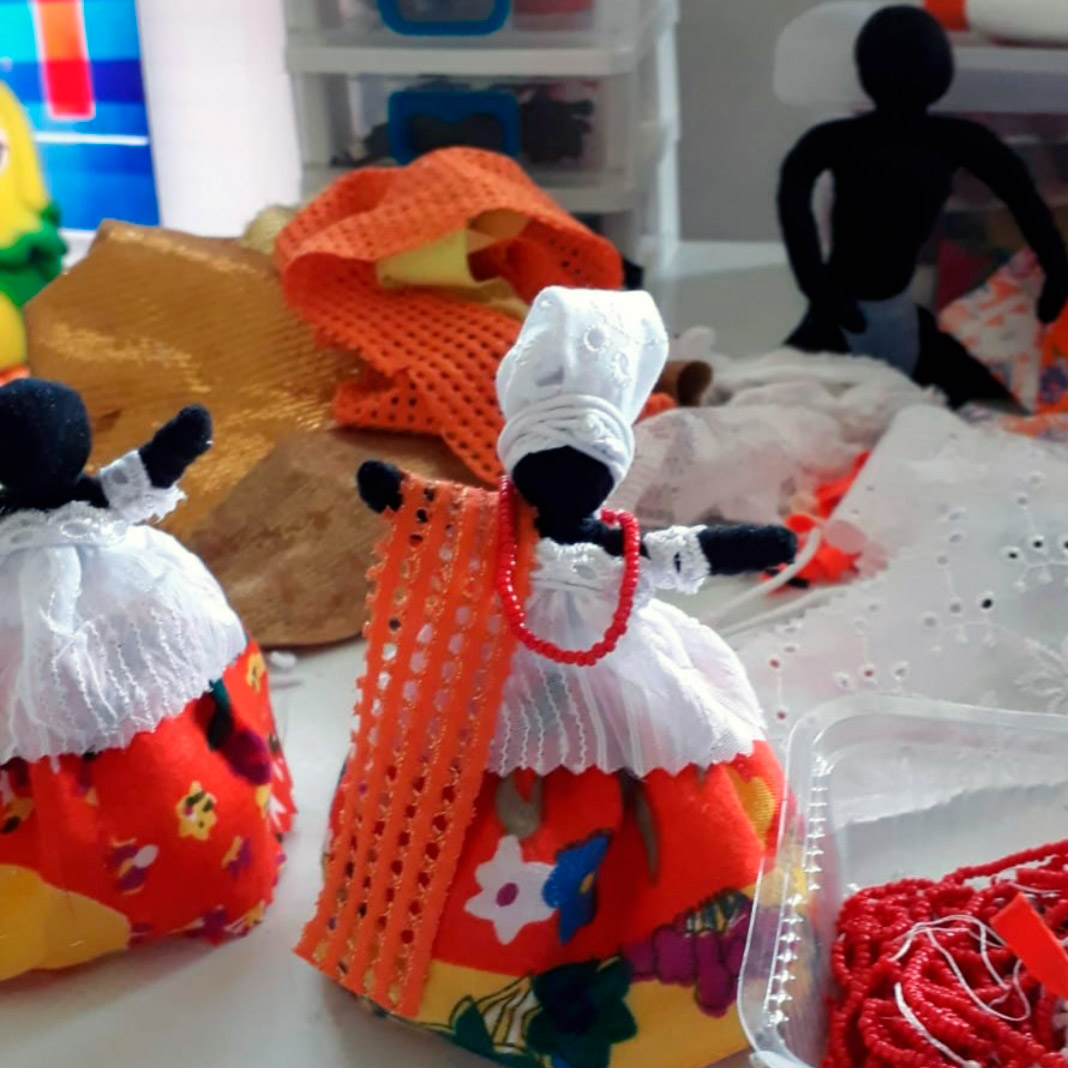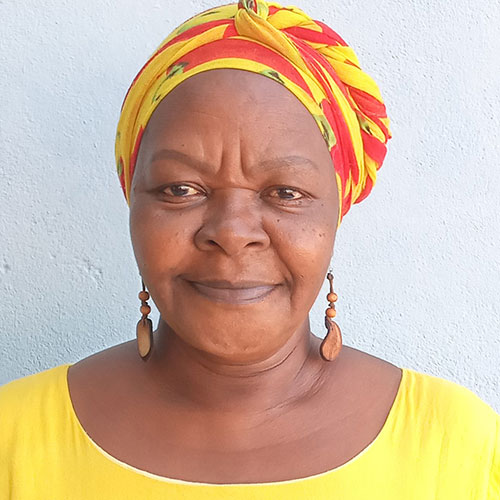Discover the true origin of Abayomi dolls
Learn more about the original story told by the creator herself, Lena Martins from Maranhão (Brazil)


Have you ever heard of Abayomi dolls?
There is a controversy about when and by whom the Abayomi dolls were created, whose characteristics are that they are black and made without glue and without sewing. Lena Martins, 71, from Maranhão and better known as Lena Abayomi, cultural animator, art educator, writer, and resident of Santa Teresa in Rio de Janeiro, tells the true story in this article.
Lena Abayomi arrived in Rio de Janeiro from São Luiz do Maranhão at the age of eight. Involved with crafts since she was 16, in 1987, Lena participated in craft fairs in some neighbourhoods of Rio de Janeiro, through a social project. That same year, she was invited to work as a cultural animator in a project at the Integrated Center for Public Education (CIEP) Luiz Carlos Prestes, in Cidade de Deus.
Her job was to facilitate the exchange between the school community and the outside community. It was the creation of a new profession. Lena was then tasked with incorporating the culture of the community and what was going on around the school into the CIEP and vice versa. She organised meetings, courses, festivals, and events that could cross understandings, make exchanges and bring information so that everyone could experience a little of that culture. Lena says that CIEP had a special, progressive board, and she was invited to work there because of the crafts she produced.
At that time, Lena questioned what her identity was, whether she was black, white, or indigenous, and in this search, she ended up going to the IPCN (Instituto de Pesquisas das Culturas Negras, RJ), where she had access to lectures with Lélia Gonzáles aimed at cultural animators, and ended up getting involved with the Black Women’s Movement.
The first National Meeting of Black Women took place at the CIEP Luiz Carlos Prestes, where she worked. As it would work, she participated in these meetings and had the opportunity to meet movement leaders such as Jurema Batista (former councilor), Neuza das Dores (one of the women nominated for the Nobel Peace Prize in 2005), and Benedita da Silva (a former senator, former governor of Rio, among other positions, and today vice-leader of a party), and that’s how she discovered her identity.
Still, as a cultural animator, she developed a project to make corn husk dolls because, in fact, she didn’t know exactly what she was going to do with the students. When he started offering the workshops, the children fell in love with the activity, as it was very easy to make dolls, with no glue or sewing required. The material used at the time was straw collected from the carts of boiled corn sellers in the surrounding area. With this activity, she got a few minutes of everyone’s concentration, which she considered a great victory.
A while later, Lena Abayomi was invited to replicate these workshops in other CIEP units and only then was it discovered that what she did was a cool thing, that it involved people, that she was able to pass on her knowledge, and that she therefore felt pleasure.
Before making corn husk dolls, she made traditional Brazilian dolls, the so-called witches, sewn and stuffed with cotton, which she saw her mother make in her leisure time in Maranhão.
In Cidade de Deus, Lena was invited to do a workshop with all the school staff, and she, once again, had no idea what to do, so she took some scraps and started making piles, and decided to make a doll for herself, while the employees did not arrive. When they arrived, they liked what they saw and asked if this would be the workshop she would give. She introduced the technique, and since then she hasn’t stopped making the dolls. All of this happened in 1987.
A while later, three more women joined her and they started making the dolls together, but there was still no name, it was just the “Black Doll Without Glue and Without Sewing”. The name Abayomi came later, by chance. Ana Gomes, a woman from the Black Movement, was pregnant and the name of the baby, if male, would be Abebe Bikila, dedicated to the first black African to win a gold medal at the Olympic Games and considered by many experts as the greatest marathon runner of all the times. And if it were a girl, it would be called Abayomi. When a boy was born, of which Lena is the godmother, they decided on the name Abayomi for the doll. Then it became “Abayomi Black Boneca Without Glue and Without Sewing”.
Lena talks about the legend that was created around the Abayomi doll:
“About when the internet started, people started saying that this doll came from another story and that they put her inside a slave ship, and many people assumed this story to be true. I never tried to deny that, for me, it was a matter for history teachers and several other areas that are not mine. I have no academic training. And that legend has gained ground, and people everywhere believe it and reproduce it.”
At the time that Lena Abayomi started this work, according to her, social movements were gaining enormous strength in Rio de Janeiro. The 100 years of abolition were being discussed, as was what was going to be done with the garbage. Among other important events, it was a very strong year. And, in Lena’s opinion, a doll born in that year, gained a very great potency, so they decided to move it to an unlikely place because, according to Lena, no one guarantees that there were children on the slave ships.
“It’s the usual thing, as it appears in textbooks, that when people talk about black people, they mention chains and other degrading things. He is either a passive victim or an executioner, in this case a criminal.
But a lot of people contact me to know the real story. I have no doubt that this false version was produced by racism. We can’t have a nice story; they’re always trying to put us in the worst situation. This type of story is always meant to break our imagination, to diminish us, so that we do not have another type of expression and strength.”
She also says that the way to make the doll is very simple and easy, and that has helped the technique, since its creation, gain strength throughout Brazil. Lena explains that, basically, anyone with a little imagination and a few scraps can make a doll. But there are more complex ways to wrap the patchwork, create volumes, and give life to the dolls, as in the case of assembling a trapeze artist or a ballerina, for example. It’s cloth on cloth, mesh on mesh until you get a shape.
“My biggest doll is almost the size of a person, “Grandma Tuninha”. She’s been with me for 20 years; she lives in my living room, and all the friends who come to visit end up adopting her as their grandmother. And the smallest one is Baby Abayomi, which is very popular at workshops; I’ve taught about 58,000 people from Brazil and abroad. I organise Baby Abayomi’s workshop with a mandala where the material to be used is exposed. I use herbs, games and music. This little baby represents a puppy, the kind that provokes tenderness, that we want to take care of so that it lives, grows, and serves life.
In all Brazilian states, there are groups and people who make and assemble Abayomis, including outside Brazil, as is the case in Córdoba in Spain and Belgium, and they always contact me for some guidance.”
The purpose of the doll
“When I made this doll for the first time, I did not imagine that the whole of Brazil would meet Abayomi, that other people would reproduce them, and that she would become a facilitator for teaching classes in various areas such as mathematics and science. This doll makes it possible to carry out any didactic work.”
For Lena, the Abayomi doll is also a way for her to contribute to the elimination of racism in society, and another purpose of the doll is to seek spaces of belonging, for example, when she makes a transverse doll of astronauts or a doll representing the president of Brazil, she sends a message, especially to black children, that we can be whatever we want, that we can occupy these places of belonging.
She ends by saying that this black doll arrived at a time when she was discovering her self-esteem and realising the difficulty that black people had in strengthening it. She says that she has always made and makes the dolls in such a way that they look beautiful and wonderful, and that it is within a positive context, so that black people and their descendants are proud of it and see themselves in that context.
The challenges
“My biggest challenge – in relation to the Abayomi doll – handicrafts without glue and without sewing; is for it to be officially considered a Brazilian product. I would like it to be registered as Brazilian handicraft, because this technique did not come from outside, it was created by me, here in Rio de Janeiro. Another challenge is to do the best possible so that other people know the techniques of making Abayomi in a diversified way, not just the doll with six knots, which many people have learned, but the doll in all its complexity.”
Lena considers it a victory to have invented a craft that enchants, that makes sense, and that people feel represented by. For her, as an artisan, this is wonderful and victorious. She says it wasn’t intentional, but rather something that happened naturally.
“Strengthening the self-esteem of black people is the basis of Abayomi.”
Did you like this article? Would you like to purchase an Abayomi doll without glue and without sewing?
Contact Lena Abayomi at +55 (21) 9 8887-5710 or visit one of the sales points:
La Vereda – Rua Almirante Alexandrino, 428, Santa Teresa, RJ
Zambê – Rua Almirante Alexandrino, 402, Santa Teresa, RJ
Orders can be placed over the phone.



